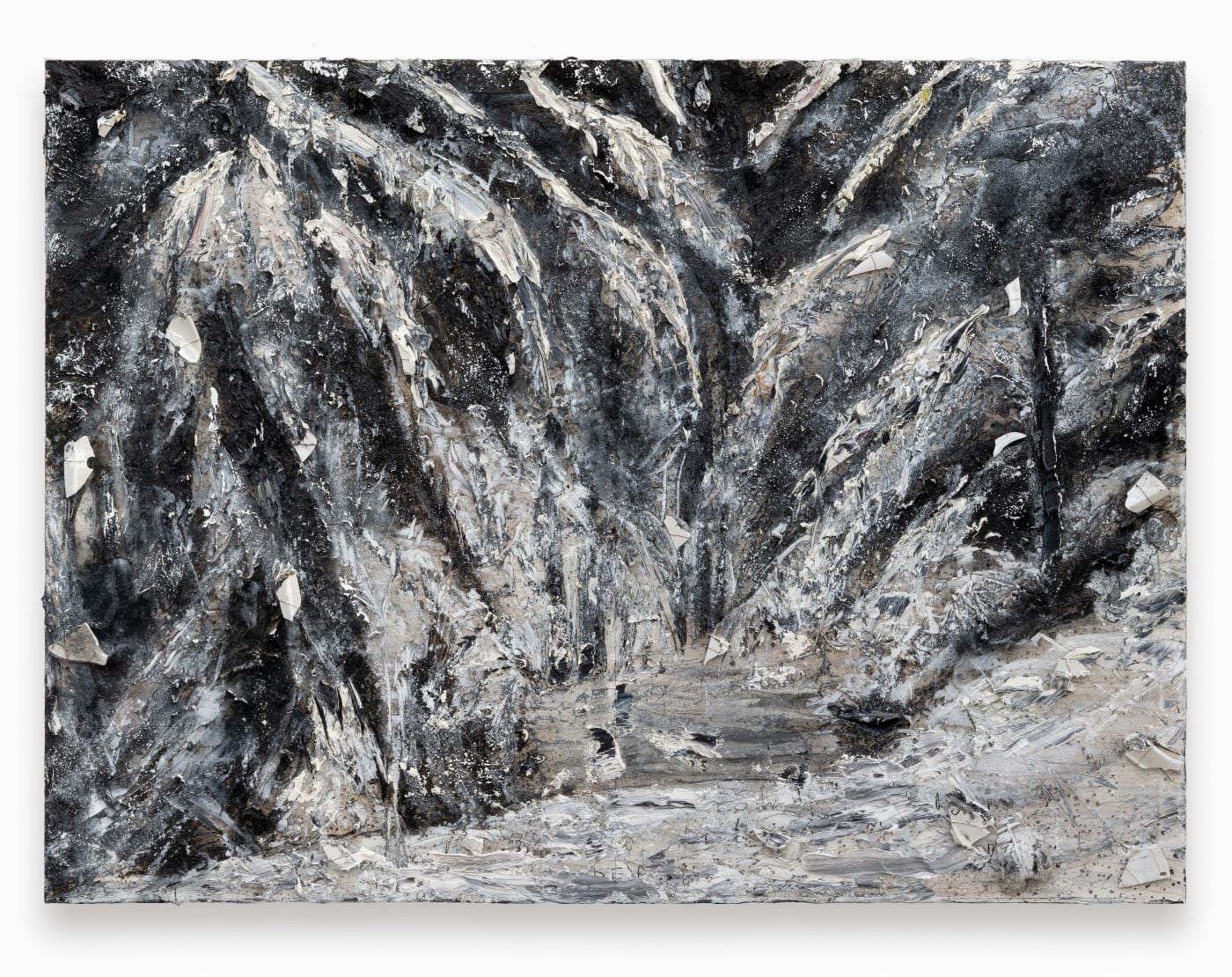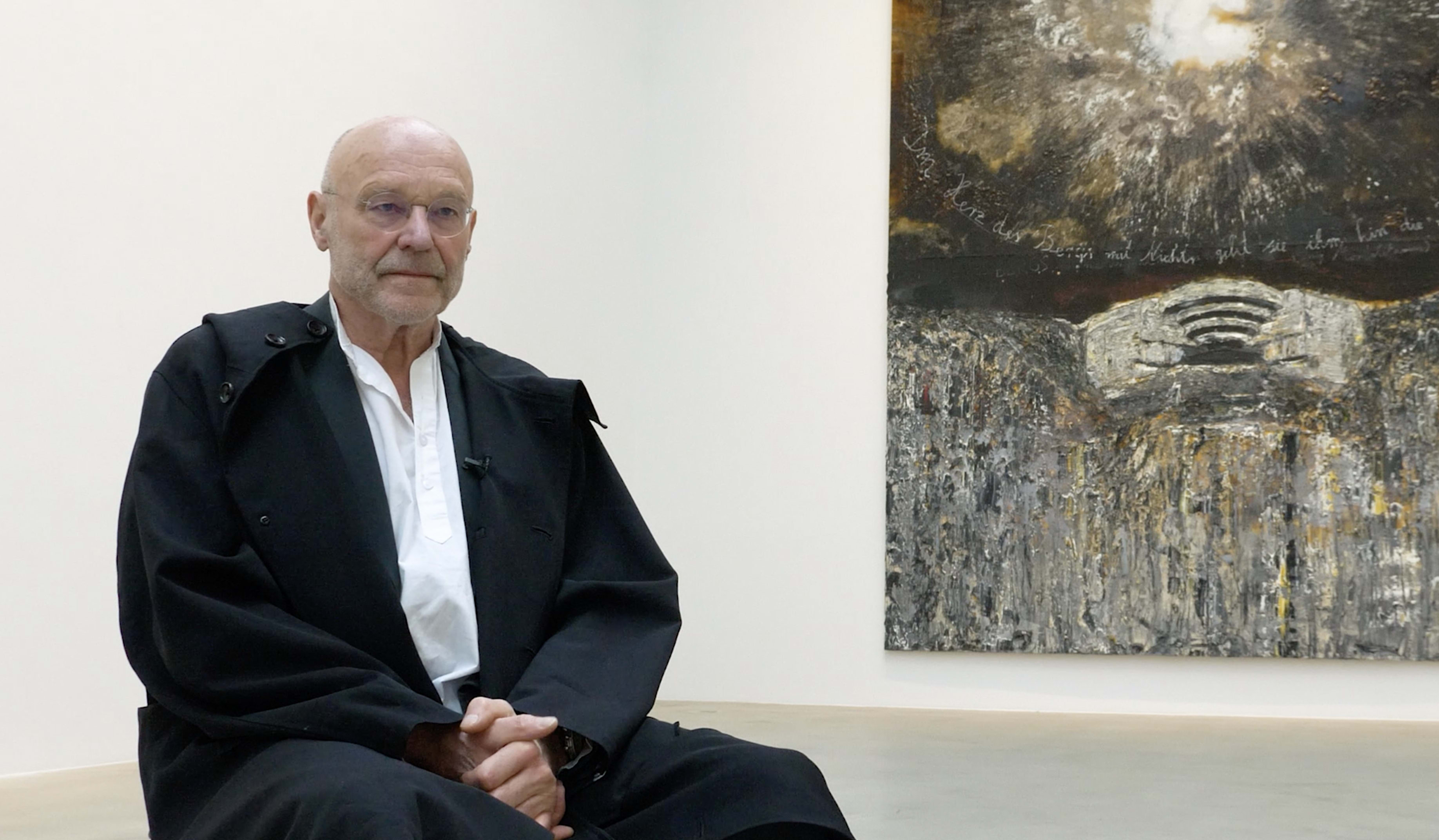Poetry is the only possible reality. Everything else is an illusion.
— Anselm Kiefer, 2021
Hommage à un poète (Homage to a poet) is an exhibition of new works by the German artist Anselm Kiefer, which pays tribute to poets Ingeborg Bachmann, Paul Celan, Osip Mandelstam and August Graf von Platen. Across the eighteen works on view, the artist brings together image and language in elegiac landscapes inhabited by memory.
The exhibition follows Anselm Kiefer’s show at the Grand Palais Éphémère dedicated to Paul Celan, whose work has had a profound influence on the painter’s practice throughout his career.
After everything has been eliminated by the flood of radiation, the poet's language is still there, unchanging, like crystallised breath.
— excerpt from Anselm Kiefer’s journal, 2021
Throughout his extensive œuvre, Anselm Kiefer is concerned with history and memory, their preservation and erosion. Born as the Second World War was drawing to a close, the artist grew up in a time during which many in Germany were struggling to face the horrors of the conflict and acknowledge the atrocities perpetrated in the Holocaust. His works emerge from these years of silence, like monuments to the trauma of a generation.

The poems of Ingeborg Bachmann (1926–1973) and Paul Celan (1920–1970) gave voice to the emptiness and the grief left by the war. Their words reverberate throughout the works in the exhibition. Here, Kiefer has written the last lines from Bachmann’s poem 'Abends frag ich meine Mutter' (When evening comes I ask my mother, 1948): ‘my mother dreams me again, / and like old songs, she meets / the major and minor of my being’.
Für Ingeborg Bachmann, 2021
Emulsion, oil, acrylic, shellac, gold leaf and chalk on canvas
190 x 280 cm (74.8 x 110.24 in)
Kiefer does not illustrate the text when he quotes fragments of the poem, but rather combines its auditory remanence with the retinal remanence of the image.
— art historian Andréa Lauterwein, 2006
At almost ten metres in length, this imposing structure can immediately be recognised as a site for repression and authoritarianism. Combined with the words of Paul Celan, who was himself a prisoner in a Nazi labour camp during the war, the painting speaks of a universal experience of incarceration and reveals how humanity continues to repeat the same atrocities throughout history and across the world.
... weiß, weiß wie Gittertünche, 2018-2020
Emulsion, acrylic, oil, shellac and chalk on canvas
380 x 950 cm (149.61 x 374.02 in)
Sometimes he materialises an image from a poem, sometimes he spreads the material of a poem in a work so that we see dust, ash, flowers, stone. We see shards, wheat, lead.
— artist Edmund de Waal on Anselm Kiefer, 2021

Anselm Kiefer’s process is alchemical, allowing words, images and materials to merge and mutate on the canvas. Here he incorporated pieces of porcelain, which give a hard, sharp edge to the thickly rendered snow of the winter landscape. Alongside the gestural strokes of oil paint, this creates a dense tactility that suggests the accumulations of history, year upon year, strata upon strata.
Für Paul Celan - Angewintertes, 2014-2020
Emulsion, oil, acrylic, shellac, porcelain, metal wire and coal on canvas
280 x 380 cm (110.24 x 149.61 in)
I think Kiefer is on a quest for his homeland. It is not a destination but a journey that is never completed, never realised. It is a return to a place of ashes, of snow. It is an endless journey, an endless return to the breath before one starts to speak.
— artist Edmund de Waal, 2021

Several of the artist’s new works feature a technique in which he applies shellac — a naturally occurring varnish — melting and burning it onto the painting to create an opalescent effect. Next to smoke-like forms or apparitions, the material adds an unprecedented, almost spiritual dimension to Anselm Kiefer’s already metaphysical paintings.
Paul Celan: du rollst die Altäre zeiteinwärts, 2021
Emulsion, acrylic, oil, shellac and chalk on canvas
280 x 380 cm (110.24 x 149.61 in)


The Zeppelinhaupttribüne is a grandstand which formed part of the Nazi party rally grounds in Nuremberg, Germany. The building embodies the country's post-war struggle with memorialisation, posing questions about the preservation and erosion of such sites. Repurposed as a high school sports field in the years following the war, the colonnade was destroyed in a controlled explosion by city authorities in 1967, severely damaging the central building, which today is all that remains. In 2019, a plan was announced to conserve what is left of the site so that it can bear witness to the era for future generations.
Poems are like buoys in the sea. You swim from one to the next; in between, without them, you are lost. They are the handholds where something masses together in the infinite expanse.
— excerpt from Anselm Kiefer’s journal, 2017
In this monumental painting a single line of handwritten poetry curves above the ominously dark horizon around the rays of light: ‘Im Herz des Bergs, mit nichts, geht sie ihm hin, die Zeit’ (In the heart of the mountain, time comes to him with nothing). They are the words of the Russian poet Osip Mandelstam (1891–1938), translated by German-language poet Paul Celan. Although the two never met, Paul Celan recognised some of his own experience of Nazi labour camps in Osip Mandelstam’s descriptions of the Soviet gulag in which he died.


The structure at the centre of the canvas evokes the bunkers and casemates, like those at the Todt Battery near Cape Gris-Nez, on the northern coast of France, that formed the Atlantic Wall: a system of fortifications built by Nazi Germany between 1942 and 1944 along the coastline of Nazi-occupied Europe as a defence against Allied invasion. Its stone walls are rendered in a ghostly pale grey that sets it apart from the rest of the scene, as it grounds the ominous landscape in historical reality.
Im Herz des Bergs, 2021
Emulsion, acrylic, oil, shellac and chalk on canvas
560 x 470 cm (220.47 x 185.04 in)
Im Herz des Bergs, 2021 (detail)
To wander slowly through the rooms and corridors of Kiefer's personal museum is to touch the back of every volume in his library.
— art historian Andréa Lauterwein, 2006

This painting is part of a group of works that reference the German poet August Graf von Platen’s 1820 ballad ‘Das Grab im Busento’ (The Grave in the Busento). The poem tells the story of Alaric, king of the Visigoths, who died in Italy after leading the sack of Rome and was buried in the Busento river. Part myth, part history, the ancient king’s fate is mirrored in August Graf von Platen’s own death from cholera in Sicily in 1835. Anselm Kiefer inscribes the title of the poem in the black sky above his densely textured painting of rocks in flowing water. Together, the words and the image take us through the layers of time, highlighting the cyclical nature of history.
La tomba del Busento e ripassano ombre lente Alarico..., 2021
Emulsion, oil, acrylic, shellac, gold leaf and chalk on canvas
190 x 280 cm (74.8 x 110.24 in)

Poetry and myth collide with modern day reality in this striking painting. Although the landscape evokes at first glance the ancient ruins of a castle, it is in fact based on a photograph of high rises the artist saw in a newspaper. From the central tower hang five strands of human hair. These are a reference to the story of Berenice II, queen of Egypt, who sacrificed her hair to the Goddess Aphrodite in exchange for her husband’s safe return from battle. Aphrodite, in acknowledgement of Berenice’s sacrifice, elevated her locks to the sky to form the constellation known as Coma Berenices (Berenice’s hair).
Berenices Haupthaar, 2020
Emulsion, acrylic, oil, shellac, chalk and hair on canvas
380 x 280 cm (149.61 x 110.24 in)
Embodying an in-between state between heaven and earth, life and death, the hair in Berenices Haupthaar is a powerful, abject reminder of our own mortality. The buildings, in turn, suspended somewhere between a glorious past and a dystopian present, echo the last word of Paul Celan’s poem about the myth of Berenice, 'HINAUSGEKRÖNT' (CROWNED OUT): ‘Babel’.























































































































































































